We get a lot of requests asking what smallmouth bass lures we use. We here at watermanatwork.com do a lot of smallmouth bass fishing on the Columbia River and it’s tributaries and have a pretty good idea what works and what doesn’t. Not all the lures below will work everyplace, everyday, but as a fisherman, what lures to use where and when is what it’s all about. We can’t tell you everything you need to know about every single smallmouth bass fishery, successful fishing has a lot to do with experience. The more you learn, the better your chances of regular success as a bass fisherman.
Smallmouth bass hang out in many different environments depending on the time of year and the water conditions. Finding the fish is the first priority and then getting them to bite a piece of plastic with hooks in it is the second. That’s pretty much smallmouth bass fishing in one sentence. Of course, there’s more to it than that, but that’s pretty much it. The fishing environment and time of year will determine which lures will be successful almost all the time.
We use three main kinds of lures for smallmouth bass fishing; crankbaits, spinnerbaits and soft plastics, which include grubs, worms and other soft baits. We’ve caught big twenty inch plus smallmouth bass with all these types of lures so it’s more about using the right lure at the right time and the right place than which type of lure works everyplace all the time. There is no single lure that is guaranteed to catch bass everyplace all the time. It’s your job as a fisherman to figure that out.
We’ll start off with crankbaits. Crankbaits are hard plastic lures with a plastic lip that will make them wiggle around and dive anywhere from a couple feet to more than ten feet or deeper depending on how fast you reel them in. Bass crankbaits usually come with two treble hooks. There are a lot of crankbaits to choose from, but we only use a few types that have proven themselves over time.
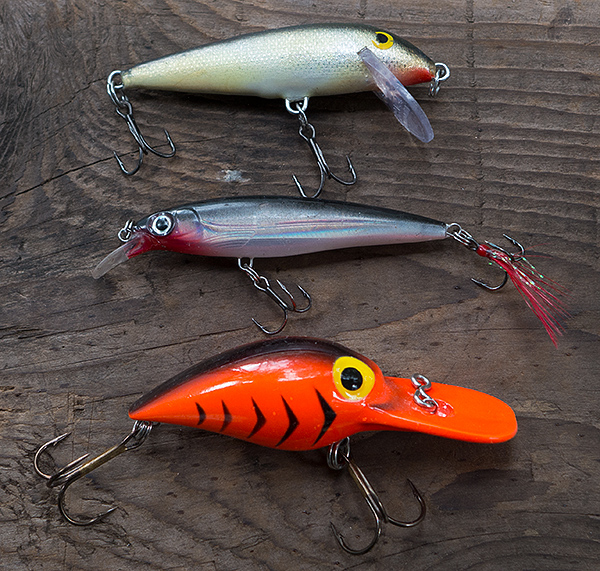
On top is a floating crankbait the dives below the surface on retrieve. This is kind of an old school lure because it is actually made out of balsa wood. This floating crankbait works best in shallow water so it would be used mainly in the spring and early summer when the smallmouth bass are spawning in shallow water when the water is cool. As the water warms up, the fish head to deeper water. The second lure is a suspended diving crankbait, or “slashbait”. “Suspended” means it will float, or “suspend” below the surface of the water and dive deeper on retrieve. This lure is also hollow and has a ball in it that rattles, but we’re not sure if that actually does anything or is just a marketing deal. This is a really nice lure and will catch lots of smallmouth bass, but it costs about ten bucks, which makes snags, which are common with smallmouth bass habitiat, very expensive. The lip on this particular lure broke off after a short time, not too happy about that. The last lure in this photo is a “Wiggle Wort”. You will probably see this lure more in our salmon fishing posts because the Wiggle Wort is one our favorite salmon fishing lures, but it works for smallmouth bass as well. We don’t catch a whole lot of bass with this lure, but all the smallmouth bass we do catch with it have been big ones, so we keep throwing it out there.
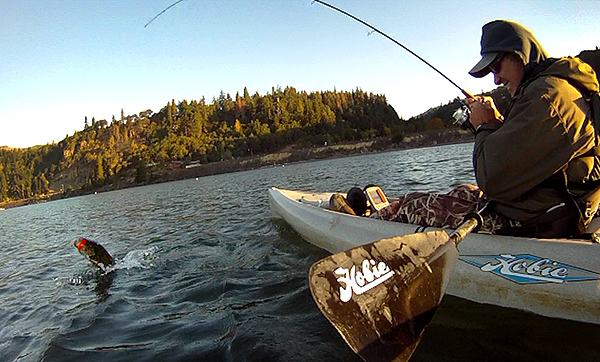
What is our favorite crankbait? Until further notice, it would be the Berkley Flicker Shad. This is a really basic diving crankbait. It works when casting for bass and also can be used to catch smallmouth bass by trolling along dropoffs or weed lines.

A big advantage of the Flicker Shad is that it is inexpensive and readily available. The watermanatwork.com home base is in the Columbia River Gorge and the nearest sporting goods store is a long trip away. The Berkley crankbait is available at Walmart for about four bucks, so losing one is not going to break the bank. We’ve caught a lot of smallmouth bass with this humble and cheap lure.

Fishing for smallmouth bass with a crankbait is a lot of fun because the bass hit the lure hard, there’s no guessing if you have a bite or not. Varying the speed the lure is retrieved or pausing the retrieve for a moment, then reeling quickly for a few feet will often induce a smallmouth bass to strike. At times, a crankbait may not work as well as other types of lures because the fish are sluggish due to water condtions and will not bother to chase what they think is an escaping baitfish, but we almost always have a crankbait on one of the fishing poles, because we have caught a lot of big smallmouth bass on crankbaits.
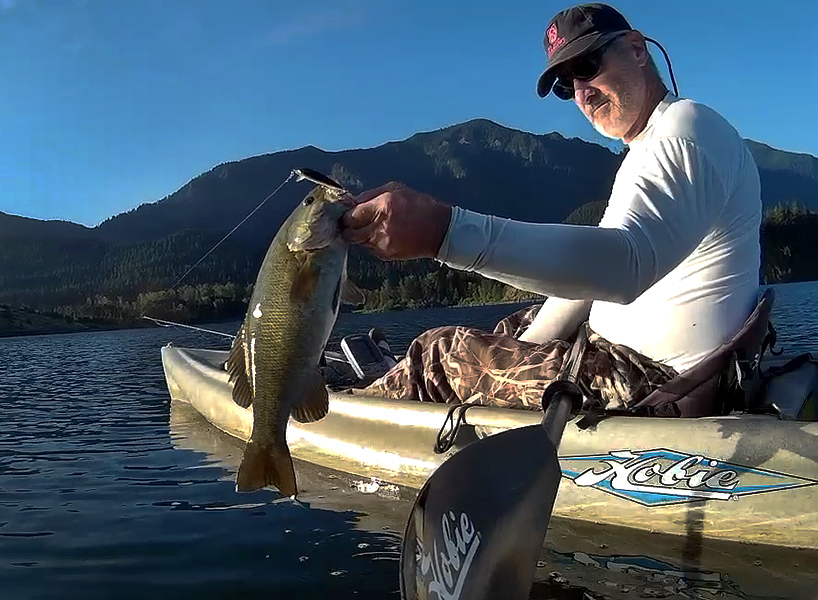
We think that placement and depth are most important when fishing with crankbaits. Color and action, not so much. Putting that lure right in front of a hungry bass is what is going to get the fish to strike. While we don’t feel lure color is the most important thing, we like to have a little bit of red on the smallmouth bass crankbaits. Red eyes are good and when the hooks on the lure get worn out from catching fish or dragging them over rocks and tree stumps, we usually replace the stock black hooks with red hooks. It seems to work, maybe it’s just one of those lucky fishing things guys do.
Next up we have spinnerbaits. These particular spinnerbaits would probably be more accurately described as “safety pin” spinner baits because, well, they resemble a safety pin. The spinnerbaits we use are equipped with a Colorado spinner blade. The round blade with a deep cup create noise and vibration that catch the attention of smallmouth bass. By adjusting the rate of retrieve, you can control the depth of the lure and the amount of ruckus the spinner blade will produce. The vibrations made by the spinner’s blade make it a good choice in murky water or at night when the fish may not be able to see the lure.

Like other smallmouth bass lures, spinnerbaits come in a wide variety of colors. Our general rule of thumb for the best lure color is that on dark days, use a dark color and when the conditions are bright, use a light colored lure. Some smallmouth bass fishermen claim that certain colors work better when the water levels are high and other colors work well when the water levels are low. The same goes when the water is moving fast or if the water is moving slowly. We suspect that this is more of a localized theory and may or may not work where you fish, but if you pay attention to the conditions and lure color, you may discover a trend where you fish for bass. Spinnerbaits are our least used lures, but we have caught fish on all the spinnerbaits in the photo above.

We have had the most success with the orange, yellow and green skirted spinnerbait. It seems we wind up using these lures during the summer when the sun is out and there are a lot of bass moving around.
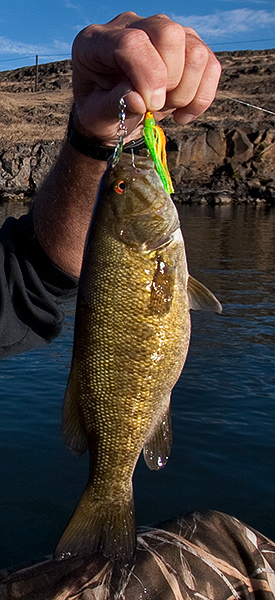
Like crankbaits, when a smallmouth bass hits a spinnerbait, there is no doubt if you have a bite or not. The bass hit the lure and the fight is on. Another great thing about spinnerbaits is that they are inexpensive. You can buy into the hype and pay two or three times as much for a “Pro endorsed” spinnerbait, but the truth is that you will most likely catch just as many bass on a lure that costs a couple bucks. We’ve caught some big smallmouth bass on spinnerbaits, but we use them mostly on summer days when the water is warm and there are a lot of medium size bass moving around looking for food. Casting a spinnerbait on light tackle is a lot of fun because even smaller bass put up a great fight.
The final group of lures we use can be grouped in the general classification of “soft plastics”. Almost every bass fisherman has a boatload of this type of lure because the come in so many configurations and colors, as well as being the cheapest smallmouth bass lures you can buy. This is important because smallmouth bass tend to hang around rocks and underwater structure like sunken trees and it is inevitable that you are going to lose some gear.

At the top of the photo there are two soft plastic swimbaits. This type of soft plastic lure has a lead core with a soft plastic body and a tail that spins when retrieved. This is a good lure to use in a place where you might want to use a crankbait but the potential for snags is high. Instead of losing an expensive crankbait to a snag, using a soft swimbait that resembles a small baitfish like a crankbait does will only set you back a buck or two instead of losing a crankbait that costs three or four times as much. These swimbaits work well when the smallmouth bass are hanging on the very bottom. Drop the swimbait to the bottom and do your best to make the thing look like an injured bait fish. We have caught some big smallmouth bass with swimbaits fished along the bottom.
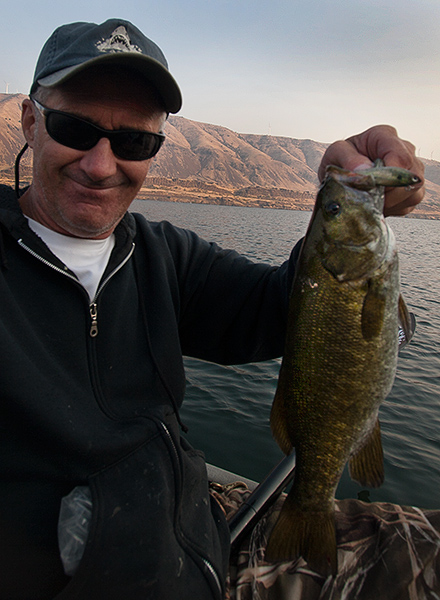
Another popular soft plastic bait are plastic worms. You may also hear fishermen call this type of plastic worm “Senkos”, which is a brand name for a kind of plastic worm. They come in all sorts of colors and different lengths. Used with a lead head hook, the plastic worms are fished off the bottom. Letting the worm settle on the bottom, raising it up, reeling in a bit and letting it fall back to the bottom works well with smallmouth bass. Often, the bass will hit the worm as it falls back to the bottom, but smallmouth bass are aggressive fish and will hit a lure any time it’s in the water. Along with plastic worms and plastic fish, there are soft plastic frogs, lizards, crayfish, leeches and grubs; all in various sizes and colors for you to spend your hard earned cash on.
Our favorite soft plastic lure, in fact, our favorite smallmouth bass fishing lure, is a leadhead grub. The ones we like best are about three inches long in a clear/reddish pink color used with an 1/8 ounce yellow lead head with red eyes. As with other soft plastics, these grubs come in many colors and sizes. The lead heads also come in a wide variety of colors and weights. Since we use lightweight spinning tackle most of the time, the 1/8 ounce size casts a long way and doesn’t get snagged as easily as heavier lures.
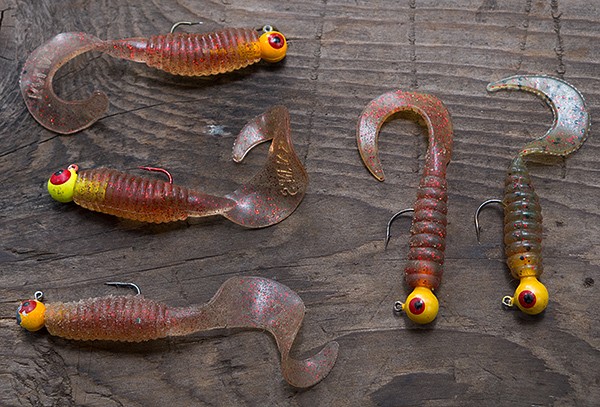
I can’t tell you how many smallmouth bass we have caught on these simple lures. Many days, this will be the only lure we use. If a lure is catching fish, why would you change it? We might have to change to a new grub because the one we’ve been using is completely chewed up, but this is definitely our “go to” smallmouth bass lure. A smallmouth bass favorite food is crayfish and I guess this looks like one to them, that’s probably why we’ve had so much success with it.
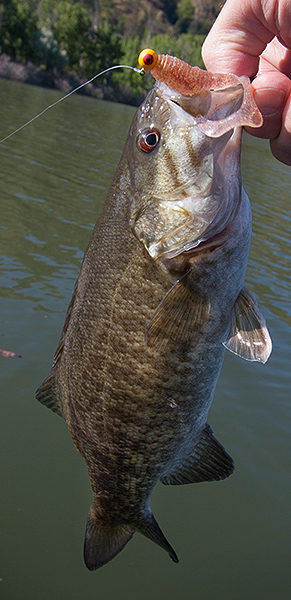
Casting a grub up against rocks on the river bank and letting the grub bounce down the rocks under water, waiting a couple seconds, then lifting the lure off the rocks or the bottom will often get a strike from a smallmouth bass that hangs along the rocks waiting for a crayfish to swim out. The key is casting the lure right next to the rocks, bouncing off the rocks is fine. You will get a few snags fishing like this, but in a kayak, you can paddle right up to the rocks and usually get your lure back. These grubs are probably the cheapest setup you can use. Even if you lose a whole pack of them, it would probably cost less than a single crankbait. That’s one of the big reasons we like these things. If it costs less to catch fish, why would you pay more? You can also cast the grubs, let them go to the bottom and sit for a second or two, then lift the lure off the bottom as you retrieve a few cranks and let the grub settle back to the bottom. Like the plastic worms, smallmouth bass will often hit the lure as it falls back down towards the bottom. Even though these grubs are small lures, we have caught many large twenty inch plus trophy smallmouth bass with them.

That’s pretty much our collection of smallmouth bass lures. Not saying we are the world’s greatest smallmouth bass fishermen, but we do OK and have caught quite a few big smallmouth bass all with the lures described in this article. As with all the product reviews and descriptions here on the watermanatwork.com website, we buy all these things ourselves just like you do. We are not sponsored by anybody, we don’t belong to any clubs and we don’t promote anything except for having fun kayak fishing without spending a lot of money. We are just guys who love to fish and we happen to use kayaks.
Now that you know what you need to catch smallmouth bass, you should get off your phone or computer and do some fishing.

Great information. Thanks and good fishing!